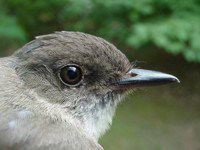|
TAKE IT ALL OFF!
Just outside our office window at Hilton Pond Center grows a 15-foot-tall Flowering Dogwood that plays host to an ever-changing animal ensemble. Even now, as we sit at our computer desk composing "This Week at Hilton Pond," we can see a long train of tiny red ants on the tree's main trunk, each following the scent trail of the ant just in front. 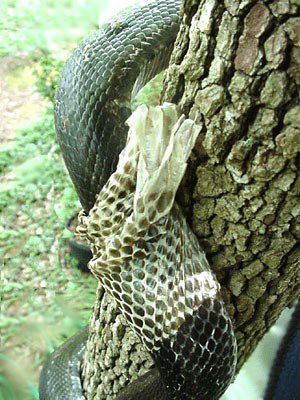 We wouldn't be surprised later today to see that same endless line marching back down the tree in search of who-knows-what, or perhaps ending up instead as an afternoon snack for a Carolina Anole lizard that has staked out his vertical territory in the ants' path. We wouldn't be surprised later today to see that same endless line marching back down the tree in search of who-knows-what, or perhaps ending up instead as an afternoon snack for a Carolina Anole lizard that has staked out his vertical territory in the ants' path.
This same dogwood tree once hid the nest of a pair of Northern Cardinals, and now a main branch supports a lightweight trap we use to capture and band hummingbirds. The most noticeable inhabitants of the dogwood is a series of Black Ratsnakes that for years have used it as a way to get onto the farmhouse roof and into the attic. In the crawl space over our heads, these ravenous reptiles perform the valuable service of seeking out and eating White-footed Mice that wander in from more natural environs.
Once or twice each week, a glance out the office window will reveal a Black Ratsnake making its way up the dogwood trunk. In the 1990s, the most obvious snake was a near-record specimen more than seven feet long. Two years ago this "biggie-sized" serpent disappeared--maybe due to death from old age--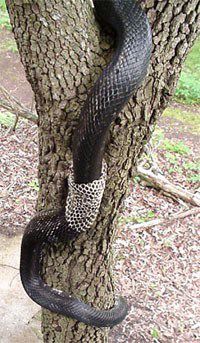 and was replaced by a smaller four-footer probably about four years old. This "youngster" is easily recognizable since he still has traces of unique oblong markings that are characteristic of newly-hatched Black Ratsnakes; it was he that treated us to an unusual observation as he climbed the tree this week at Hilton Pond. and was replaced by a smaller four-footer probably about four years old. This "youngster" is easily recognizable since he still has traces of unique oblong markings that are characteristic of newly-hatched Black Ratsnakes; it was he that treated us to an unusual observation as he climbed the tree this week at Hilton Pond.
At eye level on the dogwood is where the tree trunk first divides, and in this crotch the Black Ratsnake was "taking it all off"--his skin, that is. Right there in full view the serpent was stripping his old dead scales and revealing a new, slightly damp, and iridescent suit of armor. Unlike human skin, which flakes off constantly in tiny patches (think dandruff), the old skin on a healthy snake comes off all at one time and usually in one piece.
When a snake prepares to shed, it rubs its nose against a rough surface and makes a small tear in the old skin. Then it simply crawls out of its scaly covering, turning it inside out in the same way a human takes off a sock. The scales that are shed are completely dead, so there's no pain involved, but the layer beneath is firmly attached and removal of a live scale creates an open wound on the snake.
When the snake slithers out of its skin, it continues on--leaving a souvenir that may be collected by Great-crested Flycatchers or other birds that use them in their nests. 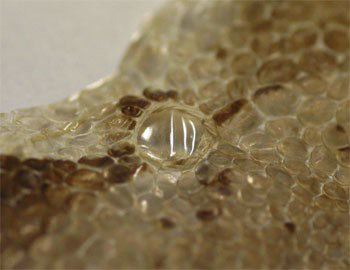 All reptiles must shed their skins as they grow; water turtles simply slough off their leg coverings as they swim, while some lizards--including that Carolina Anole mentioned above--shed their skin in large sheets that they then consume. All reptiles must shed their skins as they grow; water turtles simply slough off their leg coverings as they swim, while some lizards--including that Carolina Anole mentioned above--shed their skin in large sheets that they then consume.
The body of any snake is completely covered by scales; there's even a transparent scale that covers the eye (see photo above right of the shed skin of the Center's resident Boa Constrictor). About a week before shedding occurs, the eye of the snake turns cloudy white or blue as the old scale begins to lift away from the new one beneath. As the new scale matures, the eye again becomes transparent and a day or two later the skin is shed.
The process by which animals shed scales and exoskeletons is known as "ecdysis," from a Greek word meaning "to strip off." 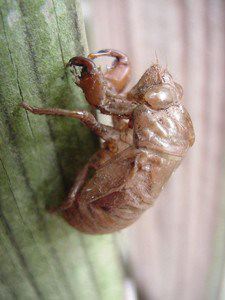 (That's why some exotic nightclub performers put the formal-sounding "ecdysiast" under the work experience column on their resumes--perhaps hoping to camouflage their true professions.) Joining snakes and other reptiles as natural practitioners of ecdysis are insects (e.g., cicadas that leave behind an amber-colored ghost of themselves, at left), and crustaceans (e.g., crayfish and crabs that become "soft-shelled' until the exoskeleton hardens). How often a non-human animals sheds or molts its external covering depends primarily on growth, and growth is often dependent on consumption of food; in other words, the more a snake eats, the more it has to shed. We suspect our four-foot Black Ratsnake will be shedding again in the not-too-distant future, because today when he climbed back down the dogwood tree there was a noticeable bulge in his belly--a sure and welcome sign that there are a few less mice in the attic at Hilton Pond Center. (That's why some exotic nightclub performers put the formal-sounding "ecdysiast" under the work experience column on their resumes--perhaps hoping to camouflage their true professions.) Joining snakes and other reptiles as natural practitioners of ecdysis are insects (e.g., cicadas that leave behind an amber-colored ghost of themselves, at left), and crustaceans (e.g., crayfish and crabs that become "soft-shelled' until the exoskeleton hardens). How often a non-human animals sheds or molts its external covering depends primarily on growth, and growth is often dependent on consumption of food; in other words, the more a snake eats, the more it has to shed. We suspect our four-foot Black Ratsnake will be shedding again in the not-too-distant future, because today when he climbed back down the dogwood tree there was a noticeable bulge in his belly--a sure and welcome sign that there are a few less mice in the attic at Hilton Pond Center.
All text & photos © Hilton Pond Center
If you enjoy "This Week at Hilton Pond," please help Support
Hilton Pond Center for Piedmont Natural History.
It's painless, and YOU can make a difference!
You may wish to consult our Index of all nature topics covered since February 2000.
For a free, non-fattening, on-line subscription to "This Week at Hilton Pond," just send an e-mail with "Subscribe" in the subject line to THIS WEEK
|
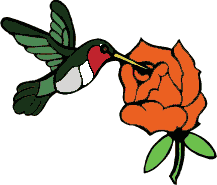 "HUMMINGBIRD MORNINGS"
"HUMMINGBIRD MORNINGS"
 We wouldn't be surprised later today to see that same endless line marching back down the tree in search of who-knows-what, or perhaps ending up instead as an afternoon snack for a Carolina Anole lizard that has staked out his vertical territory in the ants' path.
We wouldn't be surprised later today to see that same endless line marching back down the tree in search of who-knows-what, or perhaps ending up instead as an afternoon snack for a Carolina Anole lizard that has staked out his vertical territory in the ants' path. and was replaced by a smaller four-footer probably about four years old. This "youngster" is easily recognizable since he still has traces of unique oblong markings that are characteristic of newly-hatched Black Ratsnakes; it was he that treated us to an unusual observation as he climbed the tree this week at Hilton Pond.
and was replaced by a smaller four-footer probably about four years old. This "youngster" is easily recognizable since he still has traces of unique oblong markings that are characteristic of newly-hatched Black Ratsnakes; it was he that treated us to an unusual observation as he climbed the tree this week at Hilton Pond. All reptiles must shed their skins as they grow; water turtles simply slough off their leg coverings as they swim, while some lizards--including that Carolina Anole mentioned above--shed their skin in large sheets that they then consume.
All reptiles must shed their skins as they grow; water turtles simply slough off their leg coverings as they swim, while some lizards--including that Carolina Anole mentioned above--shed their skin in large sheets that they then consume. (That's why some exotic nightclub performers put the formal-sounding "ecdysiast" under the work experience column on their resumes--perhaps hoping to camouflage their true professions.) Joining snakes and other reptiles as natural practitioners of ecdysis are insects (e.g., cicadas that leave behind an amber-colored ghost of themselves, at left), and crustaceans (e.g., crayfish and crabs that become "soft-shelled' until the exoskeleton hardens). How often a non-human animals sheds or molts its external covering depends primarily on growth, and growth is often dependent on consumption of food; in other words, the more a snake eats, the more it has to shed. We suspect our four-foot Black Ratsnake will be shedding again in the not-too-distant future, because today when he climbed back down the dogwood tree there was a noticeable bulge in his belly--a sure and welcome sign that there are a few less mice in the attic at Hilton Pond Center.
(That's why some exotic nightclub performers put the formal-sounding "ecdysiast" under the work experience column on their resumes--perhaps hoping to camouflage their true professions.) Joining snakes and other reptiles as natural practitioners of ecdysis are insects (e.g., cicadas that leave behind an amber-colored ghost of themselves, at left), and crustaceans (e.g., crayfish and crabs that become "soft-shelled' until the exoskeleton hardens). How often a non-human animals sheds or molts its external covering depends primarily on growth, and growth is often dependent on consumption of food; in other words, the more a snake eats, the more it has to shed. We suspect our four-foot Black Ratsnake will be shedding again in the not-too-distant future, because today when he climbed back down the dogwood tree there was a noticeable bulge in his belly--a sure and welcome sign that there are a few less mice in the attic at Hilton Pond Center.